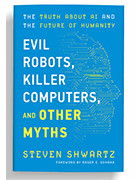Cutting through the fear of how AI will affect jobs through automation
Dive into Steven Shwartz's recent book, 'Evil Robots, Killer Computers, and Other Myths,' with a chapter excerpt on employment and the future of work.
The workforce is no stranger to sweeping changes, from the industrial revolution to overseas outsourcing. AI and automation is another iteration of a workforce revolution.
The culture of fear that surrounds AI spans decades -- from science fiction novels to pop culture. To the general public, AI represents a threat, and this is largely to do with media coverage and the lack of transparency around the technology. Famous STEM voices like Stephen Hawking and Elon Musk have publicly worried about AI affecting humans, while AI software developers are stating that their software will change the foundation of work.
Steven Shwartz, AI researcher and author of Evil Robots, Killer Computers, and Other Myths has boldly declared in his new book that the culture of fear around AI should be destroyed -- as anxiety over what AI can do doesn't accurately reflect the current iterations of the technology.
"People are worried about AI taking over all our jobs, and that's just not going to happen," Shwartz said.
Human intelligence
When the general public sees the hype around AI and what it can do, there is an idea that computers are just as intelligent as humans because they can read, create, automate and speak. However, AI systems are just computational algorithms coded by developers -- they don't have the autonomy to become generally intelligent like humans.
In order to replace humans, AI systems would need to be able to learn without coding, and stack knowledge in order to apply it to many situations. The root of Shwartz's book is that AI doesn't have the capacity for human intelligence -- because developers don't have the ability to train them that way.
"The reality is that nobody has any idea how to build such intelligent machines -- they have no more idea how to build those machines than we did 40 years ago," Shwartz said. "Forty years ago, we thought this kind of intelligent machine was imminent, and then we found out how hard it was to develop."
Developers are still attempting to tackle the issue of common sense in AI and artificial general intelligence. Currently, an AI system can understand an end goal and the steps to complete it but can't explain why it makes individual decisions. This means that the system can't explain why it acts a certain way, or the steps that led it there. If an AI system is wrong, there is little way to pinpoint the step in the process that led to an overall error.
"Whatever tasks you give AI, it's going to make mistakes that are different than the mistakes that a human makes. So it may do some things better overall, but the mistakes will be different," Shwartz said.
RPA vs. AI
The culture of fear around AI is developed from a misunderstanding of what the technology can accomplish.
In fact, what could be the biggest threat to automating jobs -- robotic process automation -- is not considered AI at all. Automating call centers and replacing remedial business processes is not AI, but computer automation.
"Most jobs are actually quite safe from AI, you're less safe from other kinds of computer automation," Shwartz said.
Demystifying AI starts with both education and realistic representations of what the technology does in the workplace. Most applications of AI focus on automating certain parts of a job to aid humans in other facets of their work. AI is excellent at classifications like computer vision image recognition, or call routing, which are normally a small part of a larger position.
"When you think about people's jobs, [image recognition and classification] might be one part of a person's job, but not the whole job," Shwartz said. "Any job is broken up into a bunch of tasks, and AI is going to enable computers to do classification tasks of a job."
What AI can't do, however, is retain the intelligence of humans and apply it across multiple actions. This incremental learning has never been developed in machines -- and there isn't a clear pathway to it.
"AI can do tremendous things, but each AI program can only do one thing," Shwartz said. "If you train a machine learning program to recognize faces, that program can't tell the difference between a dog and a cat. It certainly can't translate language and it certainly can't read a book."
For the time being, AI and automation can only assist human workers, and the fears around machines eliminating jobs and forcing humans into abject submission are about as likely as interdimensional time travel.
Explore an excerpt from Evil Robots, Killer Computers, and Other Myths, on the future of employment.








